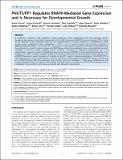PNUTS/PP1 Regulates RNAPII-Mediated Gene Expression and Is Necessary for Developmental Growth
Author(s)
Ciurciu, Anita; Duncalf, Louise; Jonchere, Vincent; Lansdale, Nick; Vasieva, Olga; Glenday, Peter; Rudenko, Andreii; Vissi, Emese; Cobbe, Neville; Alphey, Luke; Bennett, Daimark; Rudenko, Andrii; ... Show more Show less
DownloadCiurciu-2013-PNUTS_PP1 Regulates.pdf (7.745Mb)
PUBLISHER_CC
Publisher with Creative Commons License
Creative Commons Attribution
Terms of use
Metadata
Show full item recordAbstract
In multicellular organisms, tight regulation of gene expression ensures appropriate tissue and organismal growth throughout development. Reversible phosphorylation of the RNA Polymerase II (RNAPII) C-terminal domain (CTD) is critical for the regulation of gene expression states, but how phosphorylation is actively modified in a developmental context remains poorly understood. Protein phosphatase 1 (PP1) is one of several enzymes that has been reported to dephosphorylate the RNAPII CTD. However, PP1's contribution to transcriptional regulation during animal development and the mechanisms by which its activity is targeted to RNAPII have not been fully elucidated. Here we show that the Drosophila orthologue of the PP1 Nuclear Targeting Subunit (dPNUTS) is essential for organismal development and is cell autonomously required for growth of developing tissues. The function of dPNUTS in tissue development depends on its binding to PP1, which we show is targeted by dPNUTS to RNAPII at many active sites of transcription on chromosomes. Loss of dPNUTS function or specific disruption of its ability to bind PP1 results in hyperphosphorylation of the RNAPII CTD in whole animal extracts and on chromosomes. Consistent with dPNUTS being a global transcriptional regulator, we find that loss of dPNUTS function affects the expression of the majority of genes in developing 1st instar larvae, including those that promote proliferative growth. Together, these findings shed light on the in vivo role of the PNUTS-PP1 holoenzyme and its contribution to the control of gene expression during early Drosophila development.
Date issued
2013-10Department
Picower Institute for Learning and MemoryJournal
PLoS Genetics
Publisher
Public Library of Science
Citation
Ciurciu, Anita, Louise Duncalf, Vincent Jonchere, Nick Lansdale, Olga Vasieva, Peter Glenday, Andreii Rudenko, et al. “PNUTS/PP1 Regulates RNAPII-Mediated Gene Expression and Is Necessary for Developmental Growth.” Edited by Ana Pombo. PLoS Genetics 9, no. 10 (October 31, 2013): e1003885.
Version: Final published version
ISSN
1553-7404
1553-7390